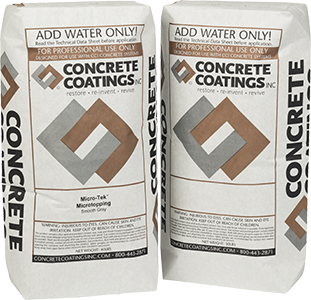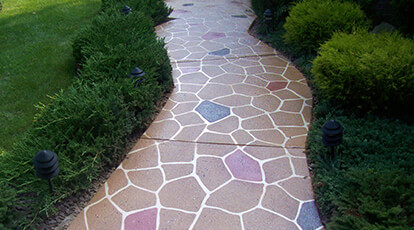Yes. You must put a base coat down prior to applying a smooth grade finish. Smooth micro-toppings are not designed for repair, spalling and uneven surfaces. We recommend the use of a single coat of RG micro-topping or the use of our G-100 and Duraset™ polymer to prior to applying the smooth grade topping.
- Overlays
- Micro-Tek™ Micro-Toppings
- Micro-Toppings - Smooth Grade

Micro-Toppings - Smooth Grade
Concrete Coatings, Inc. Micro-Tek™ Micro-Toppings are commonly used on countertops or floors where an acid stain is desired, when the concrete itself is too abused to allow for a pristine surface. Rough Grade is available in natural, while Smooth Grade is available in white and gray. They are forgiving and easy to apply. Concrete Coatings, Inc. Micro-Tek™ Micro-Toppings require rough grade (RG) as a base coat and smooth grade (SG) as a top coat. These Micro-Toppings have just the right addition of polymer in the mix for their application—just add water. A separate polymer is not required.
MUST BE USED WITH MICRO-TEK™ MICRO-TOPPINGS ROUGH GRADE.
Technical Information & Downloads:
Packaging:
Rough Grade (RG) 50 lb bag – 60 bags per pallet
Smooth Grade (SG) 40 lb bag – 60 bags per pallet
Coverage: Coverage: 200-400 square feet per bag
1 ½ - 2 gallons of water for rough grade micro topping and 2 ½ gallons of water must be added to each bag of smooth micro topping. Once the water is added it is important to allow time for the polymers to become saturated. Wait 5-10 minutes; then remix and apply.
The first application can be applied with a squeegee or trowel at about 200 sq. ft. per bag of RG and SG micro toppings. Coverage with additional coats of smooth grade, usually applied with a trowel, increases due to a smoother surface with less voids etc. The second and subsequent coats are usually applied at 300-600 sq. ft.
Reason: If the stain is not fizzing it may signify an unsuccessful chemical reaction. Stain reacts with lime and other latents within concrete substrate. When a reaction does not occur it could signify that the concrete may be too old, washed out and/or chemical residue or oils may be interfering and preventing a proper reaction. If the stain is pooling on top of the substrate, a sealer or other curing agent may still be on the concrete preventing penetration.
Solution: Make sure any chemicals on the concrete are removed. If the concrete is old or washed out or you are dealing with a very tight power trowel, it may help to add no more than one cup of muriatic acid to one gallon of Chemical Stain Note: do not add muriatic acid to turquoise; doing so will cause an unfavorable result.





